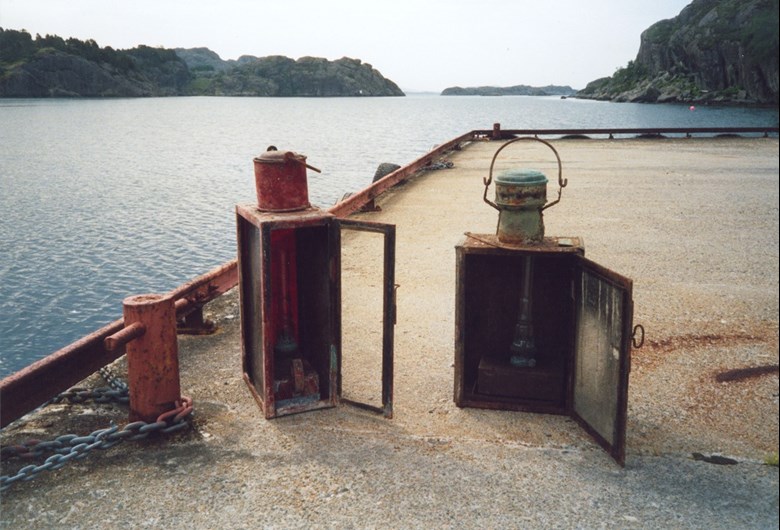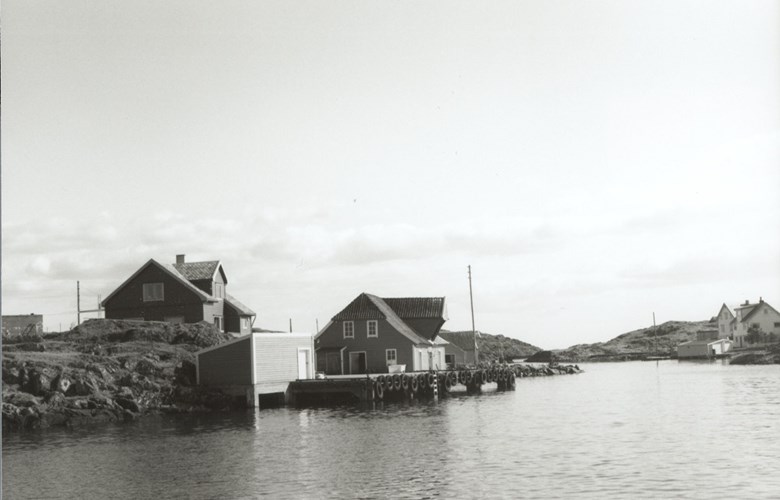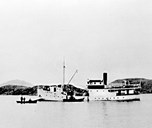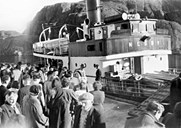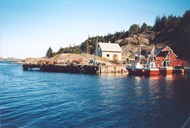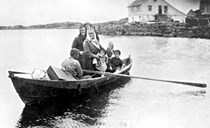Big ships, no quays
Only four years after Fylkesbaatane started scheduled traffic in the county of Sogn og Fjordane, Krakhella had an "asterik stop"(*- meaning that the ships only stopped when there were goods and passengers to or from that place - as the first in Solund, in 1862. Buskøy became a scheduled stop in 1868 and Steinsundholmen, with goods terminal at Steinsundvika, in 1975. None of these had a quay where the ships of Fylkesbaatane could dock. The first steamships in traffic there, were quite big and much more difficult to manoeuvre than the handier vessels of the Værøy and Nesøy class that came in the late 1930s. Decades passed before the first terminals were built, so the hazardous toil in the boarding boats went on, often with life at risk.
Boarding the steamer was a strain
It often involved hiding behind an islet or a headland and wait. Onboard there could be passengers, various materials for packing, fish cases, herring barrels, wooden kegs with butter, perhaps a bull, which at least in heavy sea was not a particularly sanitary situation. In rain, and often waiting until darkness, this was a strain and also a health hazard.
When the steamer arrived at last, the job was to let the boat drift and protect it as best they could against knocks against the side of the ship, while the steam winch made noise at full speed. It was important to stay away from the loads with hundred-kilo bags. Gruff officers thought they owned the world, and the trip to town was postponed for the bull.
Quays very expensive to build
There are several examples of overloading of the boarding boats in bad weather, so that they nearly went down on their way ashore. In a gale from the south, the scheduled steamship did not stop at Steinsund. The agent therefore went south to Skjerjehamn with some cattle. All three onboard perished in 1898. Only in 1924 was a quay built at Steinsund, the first concrete quay in Solund. Two years later a concrete quay was built at Lågøy.
It was a formidable undertaking for an agent to have a steamship terminal built. The scheduled steamship stops in Solund returned little profit, and financial support was next to nothing. The agent usually had to bear the costs alone.

A better life
After Fylkesbaatane in 1910 had bought the somewhat handier Gula, the number of stops rose. In 1918, 12 Solund communities had been granted stops. More were added, and from 1924 on, quays were built at all the stops, most of them in concrete.
The scheduled steamer at the quay was an unbelievable relief for travellers and agents. Gone were the inconveniences with the boarding boats, the bailing, and the tightening of the boats after rough treatment. Fish barrels, agricultural products, and groceries could be transported to and fro with ease. Even children liked to handle the wheelbarrow. The agent and people dressed for travel could sit in the shed or the shop in the terminal, stay dry, and do small-talk until the whistle blew.
A new community
The terminal gave the community a new look. The farm people had a place to go on steamship stop days. From counter and bread case, the talk would go on, and news would be heard. On the quay, herring would be salted, salmon seines dried, herring seines hung to dry as facilities were built. Children would learn to ride a bicycle, young people would romance and dance on a summer Saturday night. Vessels had a place to come alongside when people had business on shore.
The steamship terminals look much too big for the small express boats on schedule today. Nonetheless, if their function has changed, the quays still stand and are memorials of a material and social revolution, which in addition gave the community status.
